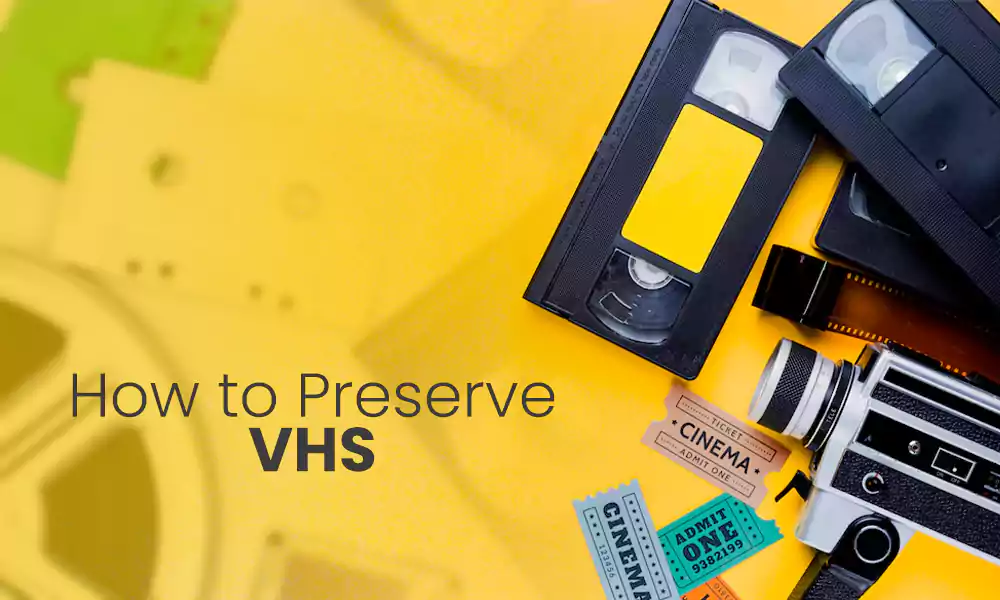If you still have VHS tapes lying around the house, it’s probably because they contain precious memories. But despite having a long lifespan (10 to 25 years depending on quality), VHS tapes aren’t the most reliable storage media.
Over time, and depending on how often you play them, the tape will age and break down. So if you don’t want to lose those memories, now is the best time to start thinking about better ways to preserve them.
The best way is to convert the content to digital and then store it in a more portable and secure location, such as your computer or the cloud. This way, you’ll also get rid of old technology around the house, like the VCR needed to play VHS tapes.
In today’s article, we’ll talk about the two most common ways to convert VHS content to digital format and the tools and steps required for each.
The fastest and least time consuming way is to use a reliable service that does VHS to digital conversion jobs. This type of service has specialized tools and technicians who know how to handle old or aged tapes without inflicting any damage.
Additionally, many of these services will perform minor repairs (when necessary) to ensure the best possible content quality. Once the job is complete, you can get the resulting footage via digital download or on a USB drive (or other storage device).
All you have to do is gather the tapes you want to convert and package them for shipment. As an additional step, you may want to clean up your VHS tapes, especially if they were not stored properly. VHS tapes have many nooks and crannies that collect dust or develop mold over time, so you may want to check the covers and see if there are any issues.
If you’re the crafty type, you might want to turn converting to digital into a DIY project. There’s nothing wrong with this, as long as you know what you’re getting yourself into.
So before you start anything, check out the steps below:
Depending on the type of conversion you want to perform, you’ll need a slightly different set of tools. To get started, you need a good VCR, which can be the most challenging part of the project if you don’t already have one.
A quick tip: VCRs are rare these days, and good ones are even rarer. If you buy a used one, test it first with a tape you don’t care for too much. That way, if the tape gets caught or mixed up, you won’t lose your precious memories.
Once you have the VCR, you’ll need an analog converter to connect the VCR to the recording device, which is typically a computer connected to a DVD player. These are much easier to find and quite affordable.
If you want to store your content on DVD, you’ll also need a DVD player with recording capabilities. Still, keep in mind that DVDs don’t have a long lifespan, so you might want to keep a good DVD to MP4 converter tool nearby for the future.
Finally, to get everything up and running, you’ll need a software tool that will capture the content from the VHS tape and convert it to the digital format of your choice. Here you have to do some research and find the software that fits your analog converter. Pay attention to the software version as you need the correct one for your converter to work properly.
Before setting up your workspace, check to see if you have all the necessary cables and adapters for operation. While the computer and DVD player (if it’s part of the setup) won’t require much setup, the VCR is something else entirely.
If you’re not used to setting up a VCR, it’s best to do some research first. This is because the VCR has several different ports that seem strange to someone not used to old technology. Also, the ports and cables are different, so you have to be very careful when trying to insert a plugin.
For example, most converter devices have three plugs for the VCR. Fortunately, they’re color-coded (usually white, red, and yellow), so all you have to do is match the colors of the plugs to the colors of the ports. Just make sure you use the output ports and not the input ones.
This means that you may need to purchase an RCA cable that has the correct plugs. This is a cable split into three at each end, with one end going to the output ports on your VCR, while the other end goes to your converter box (where you’ll find the same color-coded ports).
Lastly, the converter also has a USB port, which you will connect to your computer. Once everything is set up and the software installed, you’re ready to go.
Let it roll
The conversion process happens in real time, so you have to let the VCR play the footage while the software does its work. This doesn’t mean you have to connect the VCR to a TV; the converter is enough.
Also, before you hit play and record and let the tape run forward, it’s best to do a test capture. Let the software record for a couple of minutes, hit stop, and watch the recording. Check the settings and see if there is anything to improve. If everything looks good, reset the tape and start recording.
A quick tip: Don’t be tempted to press fast forward on your VCR in an attempt to shorten recording time. Doing so will speed up your registration as well. Also, if you stop the tape and not the recording, this will show up on your digital footage.
do some editing
Once the recording part is done, you have a bunch of digital recordings to check out. Play the footage and take notes of any edits (trimming the beginning and end, removing gaps, etc.).
It’s a good idea to do these basic edits before saving your footage for storage. This way, whenever you want to watch it (or use it), you’ll have access to good quality content.
save and store
Depending on the converter and its software, your digital video format may differ (most use MP4, MOV, or MPG). As a result, the total size of your content will also be different. Still, if you had the contents of a full tape, this usually means around 120 minutes of footage, which means the final file will be large.
So think carefully where and how to store the files. You can store them on DVD (which is not a good long-term strategy), USB sticks, external hard drives, or in the cloud. While all of these options have limits, the cloud appears to be the most secure and accessible medium. Also, if you want to share the files, it only takes a few clicks.
Saving precious memories of confinement on old VHS tapes and uploading them to the cloud can be a wonderful DIY project, but it requires time, patience, and a small financial investment. Plus, you’ll have several pieces of old technology to throw away at the end of your project.
So unless you’re prepared to throw yourself into the project and clear a lot of your schedule, you’re better off getting a specialized service. Also, this type of service will always focus on getting the best quality out of your old tapes (whenever possible). Therefore, you can get better results than if you decided to do it yourself.
Categories: Technology
Source: SCHOOL TRANG DAI



